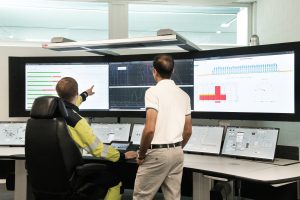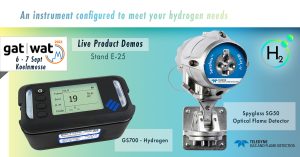|
AMETEK Land, the world’s leading manufacturer of monitors and analysers for industrial non-contact temperature measurement, has relaunched its market-leading SPOT pyrometer range with enhanced features and benefits for a wide range of industrial applications. The new SPOT+ family offers a wide range of temperature measurements from 50 to 3500 °C (122 to 6332 °F) and a choice of different wavelengths for applications including metals, glass, cement and lime kilns and foundries. The range includes monochromatic and ratio pyrometers, fibre optic heads and sophisticated algorithm pyrometers for complex materials such as aluminium and galvanized steel. A wide range of new communications interfaces makes the SPOT+ ideal for Industrial Internet of Things (IIoT) factory automation applications in addition to traditional 4-20 mA signals. Ethernet/IP, REST API and Modbus TCP/IP are standard on SPOT+, and an integrated web server provides easy access for control and setup using a standard browser. Upgraded cybersecurity functions reduce the likelihood of unauthorized access to the instrument functions. An integrated video camera provides a visible light process view alongside infrared temperature measurement, which allows sighting to be carried out safely and easily. As the video images are available via the webserver and AMETEK Land’s IMAGEPro software, alignment can be checked remotely and images logged for quality purposes. The SPOT+ can be used in the harshest of environmental conditions, and in hazardous area zones 1, 2, 21 and 22 when mounted in LAND’s high-specification EXSH enclosure. With response times down to 1ms, SPOT+ pyrometers are also suitable for fast-moving processes. AMETEK Land’s SPOT pyrometers are built on extensive research and development and have always been at the leading edge of measurement technology. The new SPOT+ enhancements offer improved connectivity for easy integration with control systems, and the confidence that data transmission is secure. Upgraded electronic and electromechanical components ensure highly reliable and accurate operations, all backed by our 36-month warranty and supported by a range of extensive accessories for installations in the most demanding applications. Dr Fiona Turner, Head of Product Management said: “The principles of infra-red temperature measurement don’t change, but over the last 10 years, there have been significant advances in automation and industrial ethernet. Customer focus on product quality and process efficiency has driven an interest in big data – and a risk of cyberattacks. “I’m excited about the potential from using SPOT+ instruments for background temperature and emissivity correction of thermal imaging systems in IMAGEPro software. SPOT+ pyrometers provide more than just temperature measurements – emissivity outputs are key indicators of product surface quality, and the facility to log visible light process images alongside infra-red temperature measurement provides new insights into process conditions and product quality.” For more information about the extended SPOT+ range of pyrometers visit: www.ametek-land.com/spot |
ABB’s digital system improves productivity and reduces energy consumption at Tokuyama cement plant in Japan
ABB has delivered the advanced process control solution ABB Ability Expert Optimizer system to control, stabilise and optimise industrial processes at the Tokuyama Nanyo cement plant in Japan. 
The commissioning of ABB Ability Expert Optimizer enables Tokuyama to reduce about 3 percent of thermal energy consumption in the kiln as well as maintain operational quality at the Nanyo plant, one of the largest single factories in Japan.
Tokuyama manufactures high-quality cement at the Nanyo plant which has a clinker production capacity of 4.54 million tons per year and supplies customers in Asia and Oceania as well as Japan. The company has invested in an efficient and sustainable factory that manufactures cement, incorporating by-products in the Nanyo plant, as well as raw material waste and fuel substitutes mainly from neighbouring areas. All materials are treated in the cement kiln to ensure they are harmless ahead of cement manufacturing.
ABB Ability Expert Optimizer controls and optimises the calciner, kiln, and cooler processes, and will further stabilise production at the Nanyo plant by properly controlling equipment and function such as induced draft fans, burners, grade speeds, etc. in each process. It is an industrial software based advanced process control solution that enables and automates the best operational decisions accurately and consistently at all times drawing on linear and non-linear model predictive control, fuzzy logic and neural networks.
By coordinating the setpoints of the different stages of the process and immediately detecting deviations among the various operation procedures, ABB Ability Expert Optimizer helps plant managers to reach set profitability and sustainability goals within significant payback time and typically provides a return on investment of less than 6 months. 
“We selected ABB’s Expert Optimizer to equalise the quality of the operation and improve the operational efficiency,” said Mr. Ryota Kakimoto, Cement Manufacturing Dept., Tokuyama. “As expected, we have significantly reduced the number of the operator manual operations normally spent on manual tasks. Through increased automated operations we can use the time saved for other tasks. We believe that this solution will also support our young operators to learn the know-how of the operation efficiently.”
“Expert Optimizer emulates an operator and provides sharp control with fewer deviations. It is already bringing efficiency and sustainability benefits to production at the Nanyo plant,” said Hiromichi Yoda, Local Division Manager for Japan, Process Industries, ABB. “Although, the timing of the introduction of the system was during COVID-19, we worked remotely between Japan and Switzerland to complete the commissioning, and this was a success with the support of our customer. As part of the ABB Ability portfolio of digital applications, Expert Optimizer supports digital transformation and sustainability aims at customer’s plant.”
Since commissioning, production has been maintained and thermal energy consumption in the kiln has reduced by 3 percent. Expert Optimizer has resulted in a near 70 percent reduction of operator manual operations and has benefits when cleaning the kiln.
ABB provides tailored automation and industrial software solutions that use real-time data enabling constant monitoring and analysis of process and assets. The ABB Ability portfolio delivers additional value with integrated digital applications for unmatched operation, maintenance, as well as process and production optimisation in the cement industry.
Addressing the energy industry’s challenges
|
This September, energy software developer, COPA-DATA UK, will be hosting two zenon Energy Day events. Taking place at Staffordshire’s Aston Marina on September 26, and then in Glasgow at Glasgow Caledonian University on September 28, the events will welcome industry professionals as well as new and existing COPA-DATA customers to gain insights on the current energy sector challenges. The events are free to attend and attendees can register online, with only a limited number of spaces left available. One of the confirmed speakers at zenon Energy Days is Garry Forfar, Energy Sales Director at COPA-DATA UK. With over sixteen years of experience in the energy and infrastructure sector, Garry will share valuable insights into the latest advancements in energy. He will also discuss the reasons why it is important to keep your automation software platform up to date, as it plays a crucial role in ensuring the reliability and resilience of energy systems. Lewis Williams, COPA-DATA’s Industry Specialist for energy who’s based in its headquarters in Salzburg, is the second confirmed speaker and will host two technical presentations. Lewis will focus on the latest in renewable energy and substation technology, before exploring the power of IIoT in supervising distributed energy resources, such as energy storage systems. Here, he will demonstrate how IIoT contributes to sustainable and resilient energy infrastructure, aimed to those interested in sustainable energy options and grid reliability. Regarding automation software, Aaron Cowdry, Technical Manager at COPA-DATA UK, will provide attendees with a comprehensive technical insight into the most recent updates and enhancements that have been implemented to COPA-DATA’s zenon 12 platform. His talk will cover a wide range of topics, such as improvements in functionality, performance enhancements and advancements in user interfaces. The Future Energy Systems Strategy Manager for Capula, that specialises in operational technology and digital transformation services, Jim Allen is another confirmed speaker. Jim holds a deep understanding of the UK’s energy regulations and the importance of the future energy transition, with over 25 years’ experience of working in the UK’s regulated and non-regulated utility and energy markets. Finally, consultant Dave Gunn, an OT Security Specialist, will also discuss and present the importance of securing vulnerable SCADA protocols for enhanced cybersecurity. To view the agenda in full, please see the website here. “The zenon Energy Day events are designed to recognise the pressing challenges and changes in the energy industry,” said Williams. “The agenda includes an array of topics, starting off with an overview of the UK energy industry market. We will then look at the renewable and substation automation options and discuss IIoT-based supervision of distributed energy resources. We’ve got an interesting mix of attendees and have dedicated time to a Q&A session that we know provides interesting conversation for our attendees. In today’s ever-changing energy landscape, it is essential to have these discussions and offer the latest updates to empower businesses on how to create a sustainable energy future.” COPA-DATA’s zenon automation software provides energy and infrastructure industries with efficiency gains through fully digitalised energy assets. Complying with industry standards like ISO, ISA, IEEE and IEC, zenon facilitates reliable power generation, distribution and smart grid management. zenon achieves this by embracing IoT and cloud technologies to control and monitor equipment for energy distribution and electricity generation from renewable sources. To learn about the latest version, zenon 12, attendees can register for one of the two zenon Energy Day events, with sessions taking place between 10:30am to 15:30pm (GMT) on both days. If you’re interested in attending, you can register today for free. Alternatively, you can find out more information about the zenon Energy Days event by contacting us here. |
Transitioning to hydrogen?
At Gat | Wat 2023 (Cologne, Germany, 6-7 September), Teledyne Gas & Flame Detection will showcase its latest technology developments for any utilities involved in hydrogen transition projects. From booth E25 in hall 7, the company will highlight the brand new high-performance GS700-Hydrogen gas detector and the recently launched ultra-fast Spyglass SG50-F-IR3-Hydrogen flame detector.
Gat | Wat is the largest annual meeting of the gas sector, providing a central forum for industry professionals to discover the latest technological developments. Among the hottest gas sector topics at present is the transition to hydrogen. Utilities across Europe and beyond are looking to introduce hydrogen into domestic supplies as a way of reducing carbon emissions and protecting homes and businesses from international gas market fluctuations.
Teledyne Gas and Flame Detection is a provider of safety-critical gas and flame detection technologies that bring dedicated safety attributes to hydrogen transition activities. By way of example, the new GS700-Hydrogen offers the ability to detect both hydrogen (H2) and natural gas (NG). This integration of natural gas and H2 detection in a single portable instrument enhances versatility and performance during hydrogen (both 100% and blends) transition projects.
Visitors to Gat | Wat 2023 will discover how the new GS700-Hydrogen simplifies gas detection across applications like outdoor and indoor leak detection, purging, barholing and pipeline gas testing. Providing safety and peace of mind, the fully ATEX-certified instrument enables utilities to quickly determine the source of gas leaks.
Notably, a major utility collaborated with Teledyne Gas Measurement Instruments, a Teledyne Gas and Flame Detection brand, to help develop the GS700-Hydrogen. Looking to introduce 100% hydrogen alongside an existing natural gas distribution pipeline, the utility used the collaborative process to ensure the instrument’s suitability for emergency response and engineering teams, enabling the precise detection and location of both H2 and natural gas leaks.
In parallel, Teledyne GMI partnered with another utility participating in a major hydrogen transition project. Here, the GS700-Hydrogen proved essential in monitoring gas leaks on test networks and measuring hydrogen during activities like purging and pipeline commissioning.
Elsewhere on the Teledyne Gas and Flame Detection booth at Gat | Wat will be the Spyglass SG50-F-IR3-Hydrogen, part of the recently introduced Spyglass SG50-F series of optical flame detectors. This next-generation IR3 device further enhances protection and safety in hydrogen transition activities. State-of-the-art optic technology and advanced software algorithms mean this high-performance instrument delivers ultra-fast flame detection (just 1.58s at 30m distance), helping to minimise any consequences through rapid response. On-board HD video enables remote confirmation of fire situations and provides valuable information on fire progression and suppression methods.
Spyglass flame detectors work by analysing the absorption of radiation caused by gases in the atmosphere and comparing it to background atmospheric absorption. The Spyglass SG50-F-IR3-Hydrogen operates in all weather and light conditions, providing the highest immunity to false alarms.
Any gas utilities undertaking or planning to undertake hydrogen transition activities should visit the Teledyne GFD booth at Gat | Wat 2023. Devices such as the GS700-Hydrogen and Spyglass SG50-F-IR3-Hydrogen ensure that utilities can focus on their hydrogen transition projects and let technology take care of safety.
Contrinex ultrasonic sensors help get to the ‘meat of it’ on a bin wash-line
The robust and high sensing performance of Contrinex’s Ultrasonic sensors, available from PLUS Automation, enables them to be relied upon to confirm or measure levels. In this application, rather than looking at a silo or tank, we look at a tote bin, but away from the normal manufacturing environment, we look at the demands of a meat-processing plant.
Plastic transportation bins which are used to carry meat, need to be checked that they have been emptied, before being sent to an automated wash station. An ultrasonic sensor mounted above a conveyor looks down into the bins and diverts contaminated bins from proceeding to the wash station.
Customer application
Inside industrial meat-processing plants it is common for portions of meat to be transported in food-grade plastic bins. Before these plastic bins can be washed in an automated wash station, a check is needed that there are no pieces of meat left in the bin. If any pieces of meat are allowed to remain in the tray and enter the wash station, they can accumulate in the washing machine, causing blockages and breakdowns.
To prevent this, a sensor system must reliably detect the presence of meat residues in the bins as they travel along the conveyor. The sensor needs to differentiate between small trivial residues and larger contamination, diverting the contaminated bins before they can enter the washing station.
The previous mechanical system which used spring-loaded wand actuators in contact with the box was unreliable and required frequent, time-consuming cleaning and adjustment. Breakdowns and interruptions to the washing process could limit the availability of clean transportation bins and impact the plant’s overall productivity.
Customer solution
Contrinex ultrasonic sensors are ideal for presence and level-sensing applications being available in both reflex and diffuse sensing technologies. For this application, an M30, metal-bodied, IP65-rated, diffuse sensor with a 20 to 130cm operating range was selected.
Ultrasonic sensors are ideal for this application because their detection is independent of the target’s colour, shape, material or surface structure. They reliably detect all items above a set height threshold, even if it is transparent, for example, plastic packaging. The vibration of the sensing face of the ultrasonic sensor, also contributes to keeping itself clean or shedding liquid contamination, in much the same way as the ultrasonic parking sensors in a car’s bumper are often cleaner than the rest of the bumper surrounding them.
The ultrasonic sensor is mounted above the conveyor, looking down into the bins as they travel past it, towards a wash machine. The sensor checks for residues, rejecting any contaminated bins using an existing mechanical diverter to shunt the box to a separate conveyor for manual emptying.
Being able to mount the sensor at some distance above the conveyor enables easier cleaning and the system has proved ideal, requiring little or no regular maintenance.
ifm dependably measures distance with millimetre precision
|
ifm electronic has launched a new generation of OGD optical distance sensors which reliably measure distances up to 2 m with an accuracy of one millimetre, even with fast-moving, reflective, multicoloured and other challenging targets. Like the existing very successful family of OGD sensors, the new models use PMD time-of-flight technology, delivering superior performance to conventional laser and red-light sensors. Unlike their predecessors, however, the new models allow users to choose from three operating modes optimised for range, precision and frequency. This means fewer OGD sensor types are needed to cover the full range of applications. Because they use PMD technology, all OGD sensors offer excellent reflection resistance and background suppression, making them an ideal choice in critical and demanding applications. In addition, their range is angle and colour independent, allowing them to operate reliably even with challenging targets such as reflective metal surfaces. In addition to distance, the new sensors simultaneously measure target reflectivity, providing additional information that can, for example, be used for product sorting. The new OGD sensors are available in heavy-duty versions with stainless steel housings and light-duty versions with plastic housings. Both versions can be supplied with either two transistor switching outputs or one switching and one analogue output. The outputs can be configured to operate based on range or reflectivity. In addition, all types have an IO-Link interface which provides full access to range and reflectivity measurements. An integral display shows the current measured value and can be configured to change colour to indicate an out-of-tolerance or alarm condition. The display can also be used to aid in configuring the sensors, in conjunction with three operating buttons built into the device. Alternatively, configuration can be carried out via the IO-Link interface. |
ROLEC aluDOOR Enclosures’ special mention in German Innovation Awards
ROLEC’s aluDOOR industrial electronic enclosures have gained a Special Mention in the German Innovation Awards. Judges praised the “high added value for users.”
Robust aluDOOR is a ‘go anywhere’ hinged-lid enclosure that can be mounted on walls, bulkheads, machines and desks – safeguarding electronics in challenging indoor and harsh outdoor environments.
At launch, these premium enclosures were originally rated IP 66, IP 67 and (on request) IP 69K. Since then, aluDOOR has now also gained an IP 68 rating. This means it can be fully immersed in water to an agreed depth greater than the 150 mm to 1,000 mm specified for IP 67 enclosures. In the case of aluDOOR, this depth is 1.2 metres for two hours.
Diecast aluminium aluDOOR’s hinged lid opens 100° to allow easy access to components. The lid can be specified with or without a recess for a membrane keypad. The lid screws and threaded inserts are A2 stainless steel for added protection against corrosion.
ROLEC has made it quick and easy to fit the lid. Its integrated hinge pin is pushed into place then secured with two tamperproof Torx T25 screws with M5 threads. Then the lid is shut and locked down with two more Torx screws. All the fixings are hidden beneath aluminium trims.
Like many other ROLEC enclosures, aluDOOR can be installed ‘lid closed’, protecting the electronics and seal, a continuous foamed-in polyurethane gasket with no join. Inside the housing, there are pillars for PCBs, mounting plates and DIN rails.
Electronics designers can specify aluDOOR in 10 sizes from 120 x 90 x 70 mm to 280 x 170 x 90 mm. The standard colour is anthracite grey (RAL 7016) with matt silver powder-coated lid trims.
Options and accessories include special colours on request, anthracite grey lid trims, a mounting plate, supporting rail, EMC gasket, and an anti-corrosion coating.
ROLEC can supply aluDOOR fully customised. Services include CNC machining, engraving, display windows, powder coating, painting, photo-quality printing of legends, logos and graphics, EMC shielding, and assembly of accessories.
For more information, view the ROLEC website:
https://www.rolec-enclosures.co.uk/en/enclosures-accessories/aludoor#top
Mencom showcases innovative industrial connectors at PACK EXPO 2023
Mencom Corporation will be showing various industrial electrical connectors at PACK EXPO 2023 — Booth #SL-6046 in the South Lower Hall. Their booth will feature hands-on displays of the company’s power, signal, and network connectors designed for automated packaging and processing equipment.
These rugged connectors utilise innovative designs and robust materials to withstand the most demanding industrial applications. Key features like quick and reliable coupling will increase efficiency and productivity for automated operations.
Mencom Corporation experts will be on hand to provide one-on-one guidance on selecting the ideal connector solution. Mencom will also showcase value-added services like custom cable assemblies, on-demand manufacturing, and more.
Please visit www.mencom.com for more details.
Revolutionary 3D wind turbulence simulation with real world data from LIDAR system

A common way of designing a new large building is to make a scale model and test it in a wind tunnel. This has been a recognised test for over 50 years but it is known to underestimate the peak loads, so correction factors are applied to provide a safety margin. Another drawback is that the wind just comes from one direction at a time whereas in the real world, gusts and the large eddies can fluctuate from many different directions at once. A Danish company, Vind-Vind, is developing a new turbulence model to capture the effects of wind on a building in natural conditions. This modelling uses real world data to enhance its accuracy, gathered with a LIDAR system using 10 ns pulses. Particles in the air reflect the laser, the changes in the returned light due to the Doppler effect are analysed using the latest flagship product of Spectrum Instrumentation, the ultrafast M5i.3321-x16 digitizer card.
Watch the wind simulation video (11 sec, 132 MB):
https://spectrum-instrumentation.com/videos/3D.mov
Per Jørgensen, CEO of Vind-Vind, explained: “At present, there are two ways to measure wind movement, either low resolution at a long distance of several kilometres or high resolution over a short distance of a few hundred meters. We created a new LIDAR-based instrument to measure long distances at a high resolution. Key to this is the ability of the Spectrum digitizer card to capture the data at its very high sampling rate of 3.2 GigaSamples per second with 12 bit resolution. This is actually more than we need but it gives us the margin to allow for ‘noisy’ conditions and weak signals. The extra bandwidth also means that we can immediately identify and filter out high frequency noise leaving only low frequency noise to be eliminated later when processing the data.”

As can be imagined, keeping track of a vast number of dust particles moving in the wind generates a huge amount of data. Vind-Vind was initially going to use an FPGA platform but rejected this approach as being too complex to programme and not having enough compute power to handle the large amount of data being created every second. The data problem was solved by using Spectrum’s SCAPP drivers (Spectrum’s CUDA Access for Parallel Processing). In this solution, the M5i digitizer with its 16-lane PCIe interface sends the collected data with up to 12.8 GigaByte per second directly to a CUDA-based graphics card instead of the PC CPU. The graphic card, in this case a Nvidia Quadro A4000 including a GPU with 6,144 cores, is processing the data much faster than the CPU of the PC with only 6 or 8 cores.
Vind-Vind’s initial goal for its computer modelling is to assess how the turbulence compares to the measured turbulence over an urban environment. After that, turbulence modelling will be improved to include the effects of a higher section of the atmosphere with wind gusts from different directions. Accurate data gathered in the real world can then be used to verify and validate the predictions of the 3D computer simulation. “With proven accuracy, our 3D wind modelling can be used to provide greater levels of safety and wind comfort as it will predict the complex nature of the real world, and not the constrained version of the wind tunnel” added Jorgensen. “Eventually it will mean that the considerable over specification that architects have to build in because of the inaccuracy of wind tunnel models can be reduced. This means improving sustainability and saving costs by cutting down on the unnecessary use of materials.”
The company envisages that its 3D wind modelling will prove invaluable for the many situations where typical wind tunnels cannot provide useful results such as the complex wind interactions of atmospheric turbulence with urban environments, clusters of wind turbines, bridges or airports.
Vind-Vind consists of two sister companies: PJ Science ApS has its focus on producing and selling the innovative LIDAR systems, and Vind-Vind ApS is the consulting company doing wind analysis for the construction industry. More info: www.vindvind.com
New Gigabit Ethernet Switch with AVB/TSN and integrated PHYs for industrial automation
Industrial automation and digital transformation are driving market growth for scalable and standardised networking solutions to address the needs of commercial Operational Technology (OT) deployments. To provide automation manufacturers with a comprehensive networking solution, Microchip Technology has announced the LAN9662 Gigabit Ethernet Switch with four ports, Audio-Video Bridging and Time Sensitive Network (AVB/TSN), two integrated 10/100/1000BASE-T PHYs and a 600 MHz Arm Cortex-A7 CPU subsystem.
To support industrial Ethernet applications, the LAN9662 features a Real-Time Engine (RTE) that provides the ability to modify the Ethernet frame in flight, enabling faster cyclical data rates and low latency. The LAN9662 is compliant with key industry standards such as the OPC Unified Architecture (OPC/UA) and PROFINET software stack, offering deterministic communication capabilities necessary for industrial networking applications.
“Expanding on the LAN966x family, the LAN9662 opens a path to scale with TSN-enabled networking endpoints,” said Charles Forni, vice president of Microchip’s USB and networking business unit. “Our solutions offer customers the advantage of starting their designs with industry standards met, supported by a comprehensive software portfolio.”
With two integrated PHYs, the LAN9662 provides extremely low latency to support various daisy chain topologies. The PHY interfaces enable fast data processing within a specified time to provide a reliable network for automation applications such as motor, conveyor and multi-axis robot controllers.
The LAN9662 supports up to two RGMII/RMII, up to two 1000BASE-X/SerDes/2.5GBASE-X/KX, and a Quad-SGMII/Quad-USGMII interface. The configurable interfaces allow designers to reach various types of physical layers or interconnects they may require.
Microchip is an established supplier of industrial-grade networking solutions, offering a broad portfolio of robust, energy efficient and highly integrated products with deterministic switching and fault-tolerant redundancy. Its products significantly reduce the complexity and overhead of deploying Ethernet across a variety of industrial applications. To learn more about Microchip’s Ethernet solutions, click here.
 Instrumentation Monthly Test | Measurement | Control
Instrumentation Monthly Test | Measurement | Control



